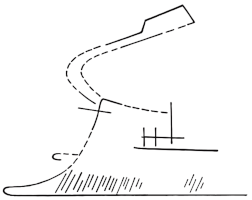Single-levelled ship to the right with a low, slightly rockered hull. Concave stempost integrating the bow projection and ending in a horn device that curves forward then upward and widens at the end into a rectangular extremity. This tip is delineated from the rest of the stempost and is filled with oblique lashings. The ram is long and thick, curving slightly upward in a smooth continuation of the keel line's curve and ending in a flat rather pointed tip. The forecastle consists of a rail rendered by two parallel timbers that extend across and project beyond the stempost. This rail is supported by three vertical stanchions. The sternpost is high and incurving, gradually tapering towards the end and capped by wider rectangular tip. The aftercastle is similar to the forecastle, consisting of a rail projecting beyond the sternpost and supported by three verticals which, however, extend significantly above the rail. There also are two short horizontal timbers rendered by a pair of parallel lines projecting from the sternpost near its base. The keel line and gunwale of the ship are rendered using double parallel lines. The mast is amidships, with a bisected V top (karchesion), a forestay and a backstay attached to the castles. The base of the mast is encased in a square box-like structure which represents the mast step system.
Single-levelled galley
A56
775-750 B.C. (second quarter of 8th century)
Athens
L: 4.4 cm
Gold fibula with a rectangular catch-plate with incised decoration
Basch 1987: 191, no. 401; Cherici 2006: 357, fig. 11; Despini 1996: pl. 181 (right); Hampe 1936: no. 88.3, pl. 7; Higgins 1961: 105-106, pl. XLVIb (top); 1969: 146-47; 1980: 100-101, pl. 14B; Kirk 1949: 122-23, fig. 8; Morrison and Williams 1968: 78, Arch. 19; Schweitzer 1971: 202, pl. 230-31 (upper right); Williams 2015: 256-57, fig. 4
Standard forms of bronze fibulae were occasionally reproduced in gold. The specimen belongs to the smaller out of two pairs of gold fibulae with engraved catchplates from the Elgin collection, and shows a ship on one side and a horse on the other. The second fibula from the smaller pair has a horse/lion on each side respectively. The larger pair bears identical engravings of a grazing deer/swastika on each side. The dating is based on the fibula's shape, primarily correlated with Tomb II from Anavyssos (MG II, late first quarter of 8th century) which had two pairs of gold fibulae of differing sizes (swastika/bird and scorpion/bird) which are very similar in form and were likely made in the same workshop. The Elgin pairs are possibly slightly later and executed by a more skillful engraver. The same workshop is credited for three other gold fibulae from an unpublished LG I tomb from Kynosarges and a single fibula now in Berlin, said to be from the Dipylon cemetery. The Kynosarges fibulae however lack incised decoration.
Although we don't have the context for the Elgin fibulae, the potential richness of the tombs from which they were obtained can be gaged by comparison with the Anavysos tomb which has provided 12 vessels, including a large belly handled amphora. The latter contained a gold chain necklace with snake head terminals, a gold necklace bead, two gold finger-rings, a gold diadem with relief, the two pairs of gold fibulae, two bronze fibulae, a faience scarab, and a large bronze bowl (possible lid).
The ship's design fits well with the other examples in bronze and contrasts with Attic ship depictions on pottery. This includes elements such as the thickened rectangular stem ornaments, the depiction of the mast step system, and the presence of a mast with a bisected V top. The artist has given thickness to most of the ship's elements by using double parallel incisions, for which the two stays and the vertical stanchions of the castles are an exception.
Basch, L. 1987. Le musée imaginaire de la marine antique. Athens: Institut Hellénique pour la preservation de la tradition nautique.
Cherici, A. 2006. “Talassocrazia: aspetti tecnici, economici, politici con un brevissimo cenno a Novilara, Nesazio e ai Feaci,” Annali della Fondazione per il Museo “Claudio Faina” 13: 439-482.
Despini, A. 1996. Greek Art: Ancient Gold Jewellery. Athens: Ekdotike Athenon.
Hampe, R. 1936. Frühe griechische Sagenbilder in Böotien, Ate¬ne : Deutsches archäologisches institute.
Higgins, R. A. 1961. “The Elgin Jewellery,” British Museum Quarterly 23:101–7.
―――. 1969. “Early Greek Jewellery,” BSA 64: 143-153.
―――. 1980. Greek and Roman Jewellery. 2nd edition. London: Methuen.
Kirk, G.S. 1949. “Ships on Geometric Vases.” BSA 44: 93-153, pls. 38-40.
Morrison, J.S. and R.T. Williams. 1968. Greek Oared Ships: 900-322 B.C. Cambridge: Cambridge University Press.
Schweitzer, B. 1971. Greek Geometric Art. Translated by P. Usborne and C. Usborne. London: Phaidon.
Williams, D. 2015. “Ship, Horse, Battle: Some Attic Geometric Fragments from the Sanctuary of Aphaia, Aigina and Attic Geometric Gold Jewellery,” in V. Vlachou (ed.) Pots, Workshops and Early Iron Age Society: Function and Role of Ceramics in Early Greece. Proceedings of the International Symposium held at the Université libre de Bruxelles 14-16 Novembre 2013. Études d’Archéologie 8. Brussels: CReA-Patrimoine, pp. 253-266.







